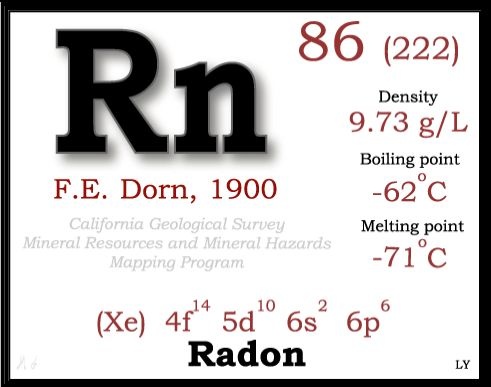
Radon (more properly known as radon-222 and a form of ionizing radiation ) is a colorless, odorless radioactive gas. It is formed by the radioactive decay of the small amounts of uranium that occur naturally in all rocks and soils. Radioactive elements decay and emit radiation. Any exposure to radiation is thought to be a risk to health - radiation is a form of energy and can cause damage in living tissues increasing the risk of cancer. Radon can seep out of the ground and build up in houses and indoor workplaces. The highest levels are usually found in underground spaces such as basements, caves and mines and higher concentrations are also found in ground floor buildings because they are usually at slightly lower pressure than the surrounding atmosphere. The amount of radon is measured in Becquerel per cubic meter of air (Bq m-3). The average level in UK homes is 20 Bq m-3.
The radioactive elements formed by the decay of radon can be inhaled and enter our lungs. Inside the lungs, these elements continue to decay and emit radiation, most importantly alpha particles. These are absorbed by the nearby lung tissues and cause localized damage. This damage can lead to lung cancer.
Controlling exposures to radon
A variety of methods can be used to reduce radon in homes and buildings including ventilation systems, radon sumps, extraction pipework and sealing cracks in floors and walls.
Sub-slab and crawlspace depressurization systems
This system uses pipes that extend from a permeable layer below the basement floor (such as gravel or drain tiles) upward through the structure, venting out the roof. This system collects radon gas before it enters the house and funnels it directly up through pipes and out of the home. If natural ventilation through the pipe system is not adequate to lower radon levels, a fan can be added in the attic to help draw gases through the system to the outdoors. Similar systems also can be installed in homes with crawlspaces.
Foundation barrier techniques
These techniques include allayer of gas permeable material under the foundation (usually four inches of gravel), plastic sheeting over that material, and sealing and caulking of all openings in the concrete foundation floor or the floor above.
Natural ventilation
By opening windows, doors, and vents on the lower floors you increase the ventilation in your house which mixes radon with outside air. This can result in reduced radon levels.
Radon Sump
Under floor extract and radon mini sumps work by creating lower pressure below floor level which reduces the ingress of radon gas into the building. This system uses an electrically powered radon sump fan that sucks the gas from underneath the floor of a house, either from an existing void under the floor or a new mini sump, and vents it into the atmosphere through a pipe.
Basic radiation protection strategies
Basic radiation strategies are contained in the ILO code Radiation Protection Workers (ionizing radiation).
Duties and responsibilities of employers
The responsibility for providing adequate protection of workers against radiations rests with the employer, even if the employer is himself a subcontractor.
When two or more employers undertake activities simultaneously at one workplace, they should collaborate in order to ensure compliance with national regulations. This collaboration does not relieve the employer of the duty to secure the health and safety of his employees.
Arrangements
ILO Code Radiation protection workers (ionizing radiation)
The employer should make the administrative and organizational arrangements necessary for controlling, the exposure of workers to radiations and radioactive materials. He should therefore appoint the appropriate staff, provide the necessary protective equipment, including radiation-measuring systems, maintain buildings, installations and workplaces, and organize work in such a way as to ensure that the radiation exposure of each worker, including his internal exposure, is controlled and complies with the provisions of this code.
The employer should structure the administrative and organizational arrangements in such a way that they operate in a smooth manner and that an effective safety program consistent with the requirements of this code is implemented.
The employer should establish a policy for the protection of the health and safety of workers, comprising appropriate measures, during planning and operation, to prevent any unnecessary exposure in the installation under his control.
Categorization/classification of workers
Categorization of workers
For the purpose of this code there are two categories of workers:
(a) workers engaged in radiation work; and (b) workers not engaged in radiation work, but who might be exposed to radiations because of their work.
Ionizing radiation does limitation
The employer should take all necessary steps to restrict occupational exposures resulting from justified practices so that they are "as low as reasonably achievable, economic and social factors being taken into account", and within the constraint of individual dose limits.
The basic principles of radiological protection expresses by the International Commission on Radiological Protection (ICRP) require employers to use does limits and ensure optimization of protection in order to keep doses as low as reasonably achievable.
The role of monitoring and health surveillance
It is important to monitor the levels of radiation that workers are exposed to and ensure that these levels are reviewed.
The main functions of monitoring radiation levels are to:
Ensure that controls provided are adequate
Ensure people use PPE when working in PPE mandatory areas
That any breakdowns in control systems are identified
Provide information to those who may be at risk and need to be under health surveillance Ionizing radiation
Radiation doses received by radiation workers must be adequately monitored and working conditions kept under review. Radiation Regulations state the maximum values which must not be exceeded. Worker's exposure to radiation is monitored using personal dosimeters.



